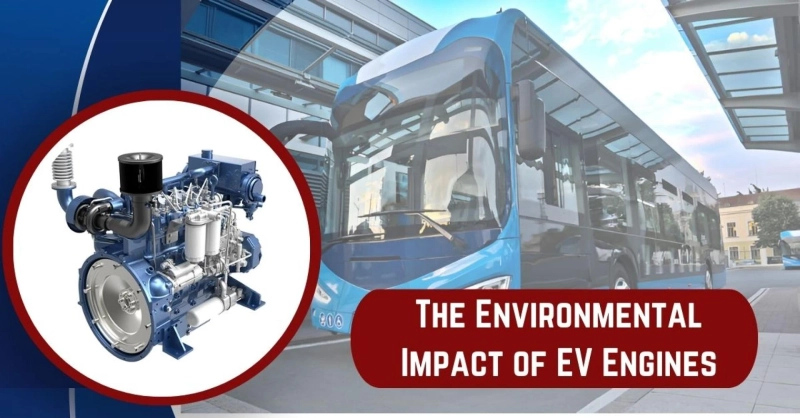From the very childhood, we have been taught how vehicles emitting greenhouse gases are making the environment toxic and hot. Yet back then we did not know how to reduce the use of it. Usage of automobiles has ever since increased as more people have bought two or four-wheelers. But now, not only in the transportation industry, wider adaptation of solar power is making way for big improvements in energy consumption. But for this article, we will solely focus on the EV engines and their impact on the climate in general.
You might think that we will only discuss in praise of EV engines, but it is not that simple. There are also concerns about the carbon footprint created by the manufacturing of EV batteries. But even then, the current world is rapidly advancing towards EV-powered automobiles. Therefore, let us begin our discussion on EV’s impact and try to come up with an answer in this article.
What are EV Engines?
We have come a long way since the day of coal-powered steam engines. Electric vehicle engines are the modern form of vehicle motors that run on the power of electricity stored in a battery. On the basic level, it is very much similar to how our laptops, and smartphones work. There are two types of engines for electric vehicles:
AC Induction Motors: These types of engines are the most common ones as they are known for their simplicity and durability. These engines use a rotating magnetic field to generate torque, which propels the vehicle into motion.Permanent Magnet Synchronous Motors (PMSMs): These motors are known to offer higher efficiency and better power density compared to AC induction motors. They utilize permanent magnets and electronic controls to deliver precise torque and power to the vehicle.How do EVs Work in the First Place?
First of all, the electricity stored in the high-voltage battery pack is delivered to an inverter. This is a crucial component of the battery as it converts direct current (DC) electricity into alternating current (AC). This inverter then controls the frequency and the voltage of the AC output, dictating the speed and power of the motor. Later the AC electricity flows into a stationary component with electromagnets known as the stator of the motor. The current then creates a rotating magnetic field.
The rotor then rotates the shaft of the motor, which contains windings or permanent magnets that interact with the stator's magnetic field. This interaction creates a force that causes the rotor to spin. Lastly, the rotating motor shaft is connected to the wheels through a reduction gear and driveshafts, propelling the vehicle to move.
How EVs are Bringing Radical Change to the Environment?
As we have already mentioned before, EVs unlike gasoline cars do not produce pollutants like smog-causing nitrogen oxides, hydrocarbons and harmful particulates. This benefit is more useful in areas where traffic congestion is more frequent and traps these pollutants. Therefore, as a result, more usage of EVs gives a chance to reduce the emission of pollutants into the air, making it cleaner. Furthermore, because of EVs, masses can rely less on fossil fuels known for their notorious pollution. This ultimately reduces greenhouse gases from the environment.
But one of the best things about these engines is that they can convert a much larger portion of the energy stored in batteries which is around 77% into motion compared to gasoline engines which can only convert around 12-30%. This means that EVs are just more power-efficient than the gasoline-powered automobiles. Furthermore, the electric motor functions as a generator when the driver applies the brakes. The range of the vehicles is increased by repurposing the kinetic energy from motion as electricity and feeding it back into the battery.
Are There Problems With EVs?
Well, things are not all rosy, when it comes to EVs, the biggest concern arises from battery manufacturing. In particular, producing batteries is a very energy-intensive process. Moreover, the production of lithium-ion batteries, a key EV component, requires mining raw materials and utilizing substantial energy. Mining of these raw materials poses a serious environmental threat. On top of that, the disposal of these batteries is a big challenge. If not done properly, batteries can leach harmful chemicals into the environment. But it is not all doom and gloom, as modern advancements are being made in battery recycling. Furthermore, EV batteries aim to minimize environmental impact and recover valuable materials.
Are EV Engines the Future?
According to the study by McKinsey & Company, a significant shift towards EVs could drastically reduce smog and improve respiratory health in cities. We know that no system is perfect, but as we have discussed, the advantages a EVs gives over its gasoline counterpart are still better. The dispensability of the batteries to the energy used to produce or charge them can have different outcomes. But it is of no doubt that EVs reduce greenhouse emissions on every basis than normal vehicles.
Remember, only producing EVs and selling them is not the solution, it is a multi-step process. By using cleaner energy-producing methods like solar power or wind power, using them in charging the batteries. Additionally, investing in research for better recyclability of old batteries is very much needed. We are already seeing advancements in battery technology that are reducing environmental impact during production and extending the range. Thus as we have said already, an EV engine is the first step towards a cleaner future, we also have to make our everyday affairs environmentally friendly. Only then we will see a greener tomorrow.



